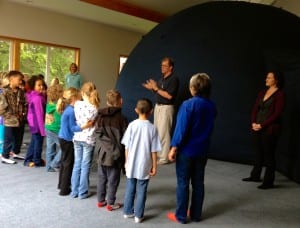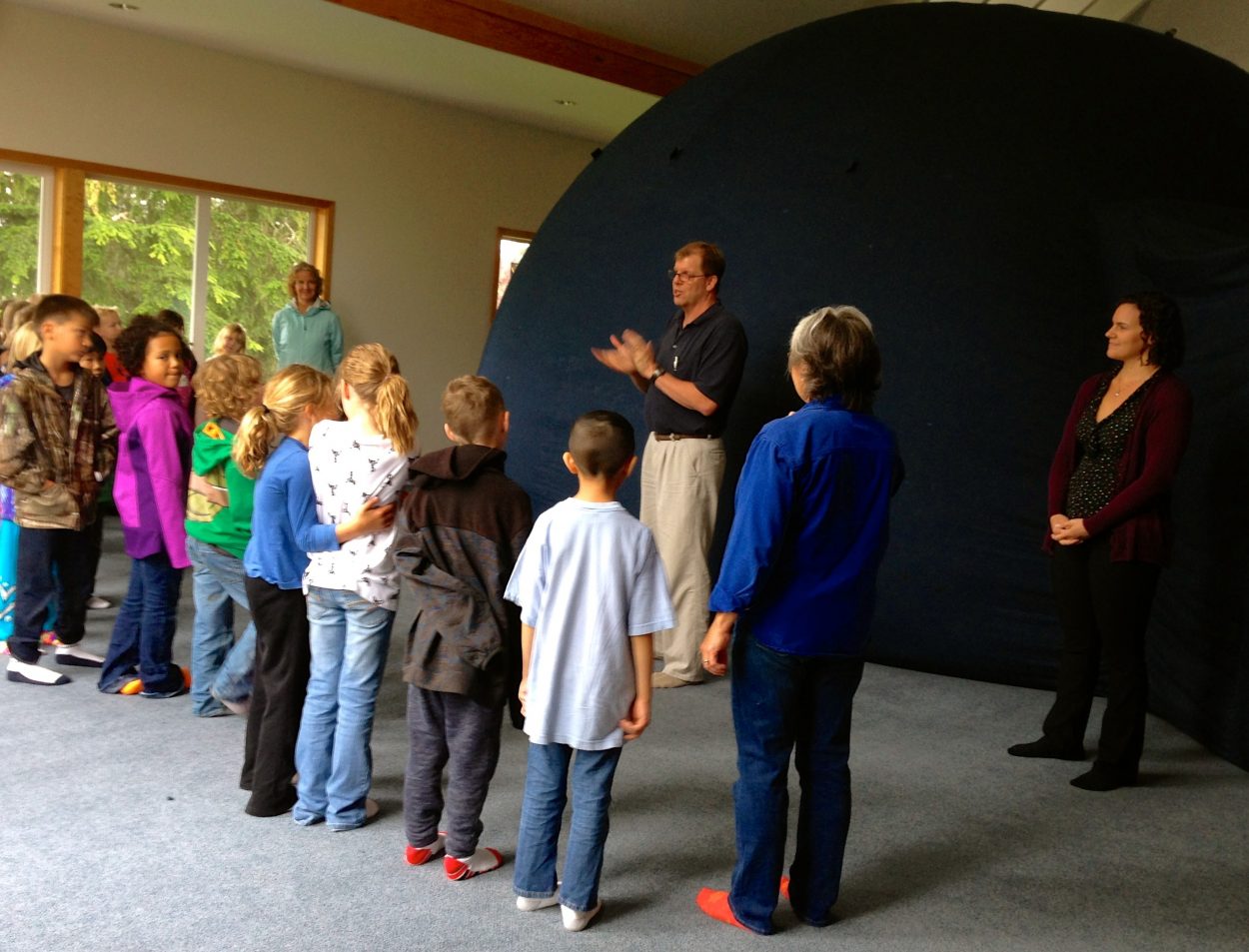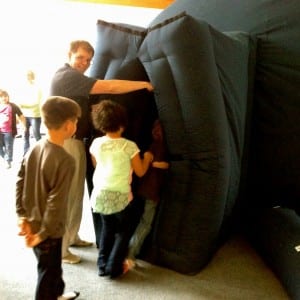
UAF Professor, Robby Herrick and Postdoctoral fellow, Emma Marcucci, address a 2nd grade class before the students enter the planetarium. Photo/Angela Denning
On the outside, this traveling planetarium is a huge, blue dome-shaped tent that takes up most of large room at the Lutheran Church’s Holy Cross House. An industrial fan keeps the tent blown up into shape. Inside though, it’s very dark. The only light is coming from a computer station in the middle. It projects images onto the dome giving a 360 degree view of stars. It almost feels like your floating in space.
About 30 children sit around the edge of the tent with their heads tilted up.
“So, here’s the Earth, where the East was or my right is…and here’s the moon,” says Emma Marcucci, a postdoctoral fellow at the Geophysical Institute at the University of Alaska Fairbanks, where the planetarium comes from.
She clicks a button and the moon pans across the top of the dome.
“So you see that there are lots of craters and bright parts of the moon,” Marcucci says.
The moon zooms in closer and closer giving the sensation that it is coming down right on top of you. The children “oooh” and “awww”.
“So that is our moon fly-by so if we were on a spaceship and we were coming very close to the moon and then rotating away that’s what the moon would look like,” Marcucci says.
The moon fly-by definitely has the “wow” factor but there are many other scenes that also leave mouths gaping open.
“So, I’m going to make time move a little bit faster,” Marcucci says. “One fun thing about the planetarium is we can make the sun and the stars go by really quickly. So, watch the sun and you’ll see it start to see it move a little bit faster. That’s if it were moving 300 times faster than normal. And now I make it go 3,000 times faster. Look at it go.”
The skies that are being projected are those specific to Petersburg on the globe. Here, Marcucci shows how the sun changes from month to month.
“So we’re in September, so in September we have some daylight and some nighttime,” Marcucci says. “Now what happens in the middle of summer? Do we have more light or more dark? More light, that’s right. So in the summertime…let’s go back to June…Did you see how the sun got higher? I’m going to move forward again, so July, August…see how the sun is moving higher? If we go to December, what’s going to happen? The sun is going to go really low and so in Alaska because we are so far North the sun gets really low and really high for us.”
Later on, with a red laser light, Marcucci points out different constellations. There are so many stars lit up in the planetarium that the constellations are kind of hard to make out. . .until Marcucci adds another layer.
“I’m going to turn on the constellation line so you can see that a little bit better,” Marcucci says. “So, these are all of the different constellations that we can see in our sky.”
Also visiting with the planetarium is Robby Herrick, a research professor at the Geophysical Institute at the University of Alaska Fairbanks. Herrick says he became interested in space because so little is known about it.
“For me, the appeal is exploration,” says Herrick. “Of course, we’re in a time now where everything on Earth has been explored to some degree and the reason I got into planetary science is it’s a chance to see stuff that has not been seen before. We’re still exploring the planets and seeing what they look like and, you know, each new mission allows you to see something else that nobody’s ever seen before.”
If you’re interested in space and you can’t become a scientist yourself you can always visit a planetarium.
“And pretty much anyone going into the planetarium no matter their age has the same expression on their face of just wonder and fun,” Marcucci says.
There are also on-line sources you can tap. There’s NASA’s website nasa.gov where you can learn about the different space missions and the images from those missions. You can also google “NASA photo journal” which takes you here and check out the latest photos.











